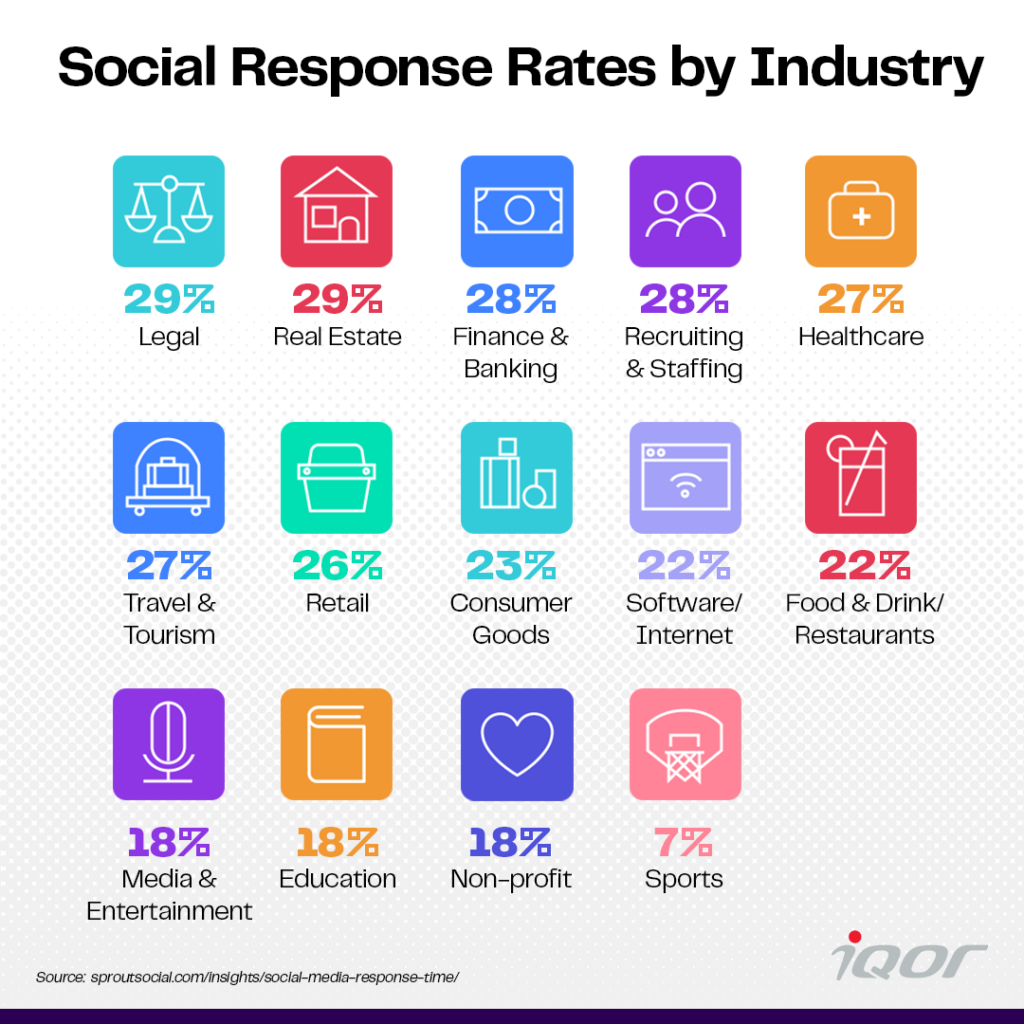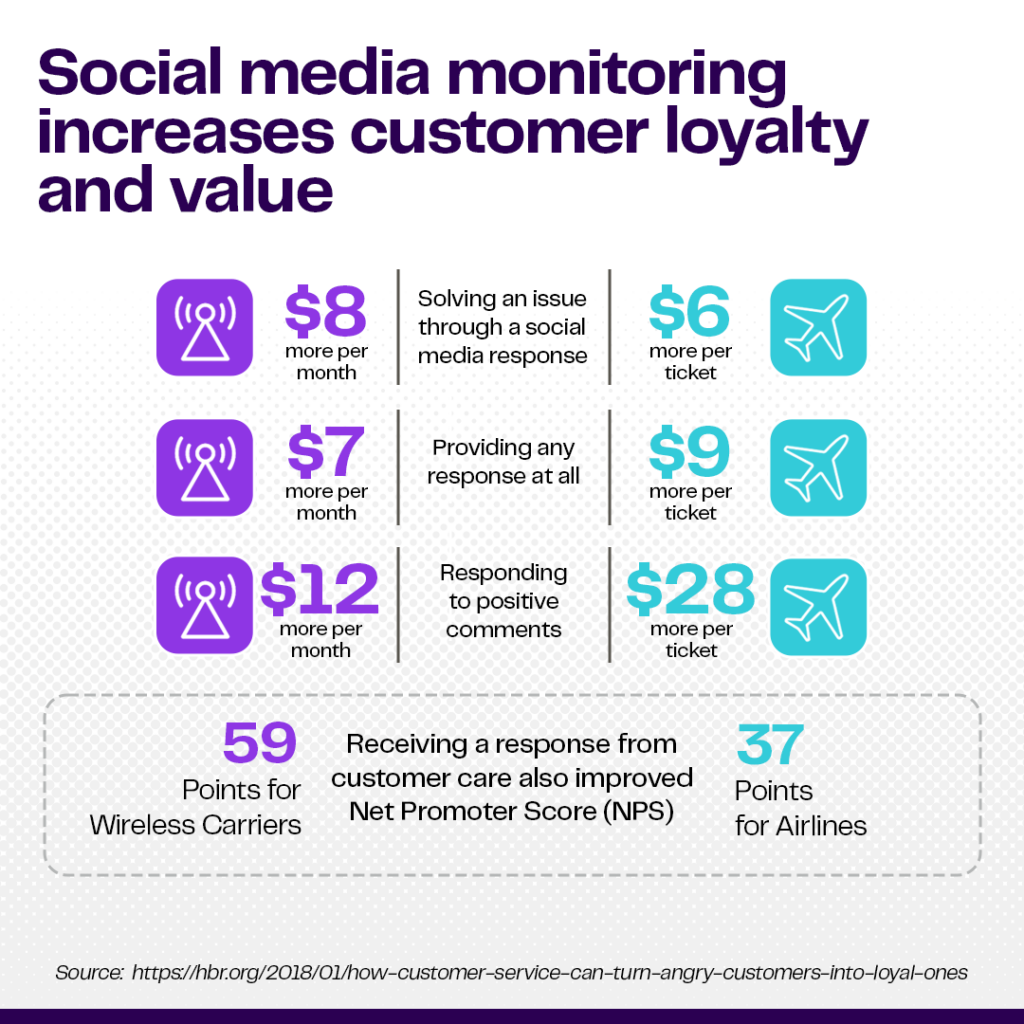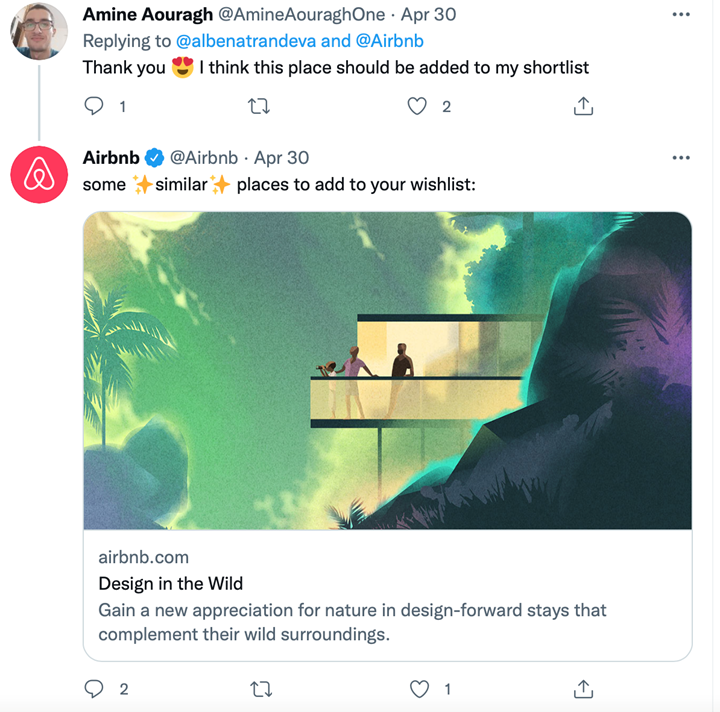Learn why your brand needs social media monitoring as part of your customer experience digital transformation.
Customers now have the power to shape public opinion, which they can use to their advantage. They can use social media platforms to shape customer experiences in ways that would not have been possible 15 years ago. And with the proper social media monitoring plan in place, businesses have access to a goldmine of opportunities to strengthen customer relationships along their journey. Do you know how successful your brand is using social media to provide an exceptional customer service experience?
Many brands struggle to respond in a timely manner on social media, and sometimes, at all. The response rates across industries are well, a bit abysmal, with the highest rate going to legal and real estate at 29 percent.

Part of the challenge of low response rates could be the fact that the number of social media users just keeps growing. In 2021, it was reported that there are 4.5 billion social media users throughout the world, with nine out of ten internet users visiting social media every month. And with that number set to increase every day, it’s ever so critical for businesses to have a solid social media presence and make the most of the platforms when engaging with their customers.
The takeaway? Brands that can exceed the industry-wide benchmarks can bet that they will beat out the competition and win more loyal customers. The challenge, however, is that many companies don’t always understand how to monitor social media for meaningful customer interactions or its implications for not doing it well or at all.
In this post, we dive deep into the importance of social media monitoring in supporting current customers and some of the social media tools available. Your brand can improve customer interactions on social media channels and better understand which issues matter to your customers by understanding social media monitoring in the customer experience.
What is social media monitoring?
In essence, social media monitoring is a brand’s way of providing customer support over social media. With social media monitoring, customer care agents monitor your company’s social media platforms such as Twitter, Facebook, LinkedIn and Instagram and respond to customer posts and comments.
Social media monitoring also enables businesses to monitor mentions even if a hashtag isn’t used, as some consumers may refer to your company without calling out your brand by name. By tracking these references, companies can respond to customers promptly and address concerns before they get escalated to the customer helpline or before they become the next trending topic on Twitter.
What is the difference between social media monitoring and social media listening?
Despite several significant distinctions, “social media monitoring” and “social media listening” are frequently used interchangeably. From a high level, the processes are comparable, although they’re done for different reasons.
For instance, customer support teams frequently employ social media monitoring to react to what customers are saying, respond to complaints, and answer questions. Social listening, on the other hand, aims to listen to customer experience insights from a broader level to potentially make enhancements to the brand’s services and products.
Both are valuable processes to a brand, but for the purpose of this article, we’ll focus on social media monitoring as this is what brands primarily use within their customer care programs.
What do brands track with social media monitoring?
While there are many types of metrics you can track in a social media conversation, here are some of the essential marks to keep an eye on:
- Branded terms and brand mentions: The easiest way to stay tuned into social media conversations concerning your business is to track all brand mentions your brand receives on social media. This includes tagged and untagged mentions.
- Customer sentiment: Not only do you want to know how often your brand is mentioned, but you want to know if customers are happy or upset with your brand.
- Reviews: Social media monitoring can help you track what people say about your company on native social media review sites, including Facebook, Yelp, and Google. This gives you opportunities to respond directly to mitigate negative reviews and thank those who post positive reviews.
- Hashtags: You’ll want to track hashtags that are relevant to your business and industry so you can get a sense of how your target audience perceives your company and competitors.
- Competition: Speaking of such, use social media monitoring to see how people talk about your competitors and how competitors are engaging with their customers.
Social media monitoring increases customer loyalty and value
Social media monitoring tools can help brands respond to consumers faster. Not only does this allow your customers to feel heard, but it’s good for revenue too. A study by Harvard Business Review found that customers who have a complaint handled in less than five minutes go on to spend more on future purchases.

In the same study, simply receiving a response, any response at all, increased the customer’s willingness to pay later even in cases where customers were extremely frustrated. For airlines, providing any response resulted in the customer paying almost $9 more for a ticket on that airline in the future. For that same airline, successfully solving an issue can create more value by about $6.
For wireless carriers, customers who got any response to their negative tweet were on average willing to pay $7 per month more for a wireless plan from that company than customers who got no response. For cases where the issue was resolved, they were willing to pay $8 more. And even if the agent couldn’t resolve the issue, simply responding resulted in a customer’s willingness to pay $6 more.
Receiving a response from customer care also improved Net Promoter Score (NPS) by 37 points for airlines and 59 points for wireless carriers.
The lesson here is that no matter how frustrated, customers always appreciate a response, even if it’s a simple acknowledgment. By defusing their aggravation in any capacity, whether it’s an empathic response, quick answer, or problem resolution, brands can steer the customer back on the path to loyalty and satisfaction.
Responses to positive comments pay out too
The Harvard Business Review study mentioned above also found that the highest increases in a customer’s willingness to pay came when brands responded to a positive comment about its company. Receiving a response to a positive comment generated $28 more for a future airline ticket and $12 more per month for wireless plans.
The takeaway here is that customers who say good things about your business on social media are highly valuable. They are your advocates and brand loyalists. By acknowledging them and thanking them for their kind words, you are generating happy customers and more revenue.
How do brands use social media monitoring?
1. Answer Questions
Let’s assume you run customer support at an airline and a person tags your brand name on social media to determine the price of checking a bag. If your company uses effective social media monitoring, a customer support rep will respond promptly to that customer with up-to-date pricing information and any other information they may need. The customer may have follow-up issues, so the representative should stick around to respond quickly if there is anything else the customer needs help with.
A great example is the gaming brand, Xbox. The company is actually a winner of the Guinness World Record for “Most Responsive Brand on Twitter” (yes, that’s a thing!). They were noted for being able to reply to their customers in less than three minutes on average, contributing to their dedicated customer service handle @XboxSupport.

Social media monitoring tools can also be used to respond to suggestions which can lead to making improvements to your products or services. When someone made a product suggestion on Twitter to Tesla, they implemented the change within a couple of weeks. Way to show your customers that you’re listening!

2. Resolve issues or complaints
Although not all concerns are critical, problems and complaints must be addressed promptly to assist distressed consumers and limit the spread of negative sentiment on social media.
Imagine the same customer is later upset that the plane’s in-flight Wi-Fi didn’t work correctly in the airline scenario. In today’s connected world, the airline has the opportunity to address the issue quickly before the comment negatively affects their brand’s reputation.
Leaving complaints unattended is like abandoning calls at your contact center, but worse. Not only do customers not get the help they need, but you also now have thousands of people who see that you ignored a customer.
Social media monitoring can help agents prioritize customer complaints so they can respond quickly or invite the customer to a private interaction to prevent the exchange from escalating publicly.
Brands can also use social media monitoring to triage complaints and avoid crises with broader messaging. If there’s a common issue springing up, you can bring in your public relations or communications team to minimize the potential of negative press.
3. Thank customers for positive feedback
While it’s true that some customers voice negative comments on social media platforms, there is also good to be found as well! Keep an eye out for the positive comments people make about your business on social media. Too often, these postings go unnoticed because customer support teams don’t react. Not responding to positive customer comments is akin to hanging up on a happy customer without saying thank you.
Best social media monitoring practices say you should respond promptly to the customer. For example, “We’re happy to have helped; please let us know if there’s anything else we can do to assist you further…” Or, say thank you in a way that’s true to your brand’s personality, like Zappos:

4. Promote more products and services through replies
People are typically extremely honest on social media, so when someone is excited about a product or an excellent service experience, brands should take advantage of the opportunity to engage with them.
You can use what you know about a customer’s recent purchase to offer them (and your other followers) related products and experiences in an organic way.
Take Airbnb, for instance. When a customer announces on Twitter that they’re taking a trip using Airbnb, the company will usually follow up with a friendly conversation like, “Where are you heading?” If the customer responds with the destination of Miami, for example, Airbnb will reply with their featured experiences in that city.
When Airbnb customer support staff makes these kinds of interactions, they are essentially getting free marketing. Its replies also show up in the mentions of other friends tagged in the response, further multiplying the reach of this tweet-by-tweet campaign.

5. Increase customer engagement
If you want more people talking about your business or receiving more reviews, then social media monitoring is a great way to engage with customers and provide calls to action. Like the Airbnb example, you can invite customers to engage with your brand through online surveys and even tweeting out discounts and promotions.
The food grocer giant Whole Foods is a notable example. Not only does it share healthy recipes and relevant stories, but it also routinely hosts Twitter chats too. It also gets followers talking about the brand by frequently sending out calls to action, such as asking Twitter users interesting questions or encouraging them to share or vote for favorite recipes.

Social media monitoring tools
Now that the benefits of social media monitoring are clear, you’re probably wondering how to do it. The good news is that there are plenty of tools out there to choose from. We’ve compiled a list of tools and their targeted users to help you narrow it down.
- Sprout Social: A powerful, all-in-one social media management platform that customer care teams use to deliver responsive support.
- Sprinklr: Prides itself in being the only unified customer experience management platform. Uses AI to create insight-driven strategies across 30+ channels.
- Hootsuite: Provides a dashboard to oversee your social media management and marketing while creating a one-stop shop for your social media marketing needs.
- TweetDeck: This Twitter-owned social media monitoring and management tool allows you to schedule tweets and track hashtag mentions. And it’s free!
- Talkwalker: Provides actionable social media analytics and monitoring using AI.
- Geofeedia: Integrates location-based analytics into its social media management strategies.
- Snaptrends: Another geo-based social media management tool that turns location-based insights into suggestions for next steps and actions.
- Oktopost: Designed specifically for LinkedIn, this tool automatically tracks groups and discussions.
Develop your social media monitoring CX strategy first
This is a partial list of social media monitoring tools. For a complete list of tools visit the G2 page on this topic.
The tools listed above are extremely useful. That said, your strategy for interacting with customers on social channels should be the first step. A customer experience program that leverages social media monitoring is a valuable way to respond to customers and prospective customers whether they’re expressing negative or positive sentiment. And when it comes to customer care, providing a meaningful digital customer experience should be a baseline part of your strategy. Let us know if we can help.
